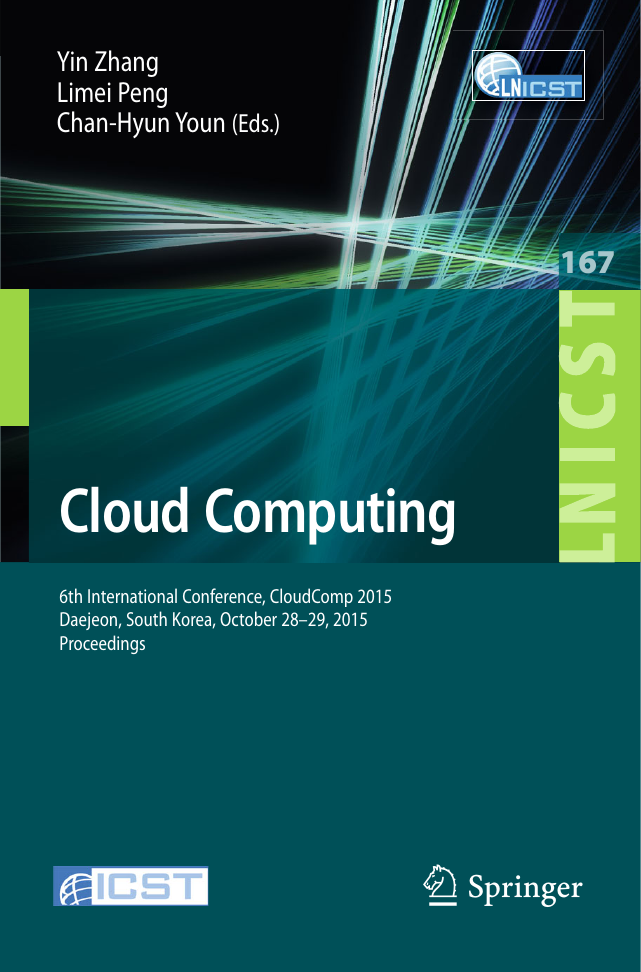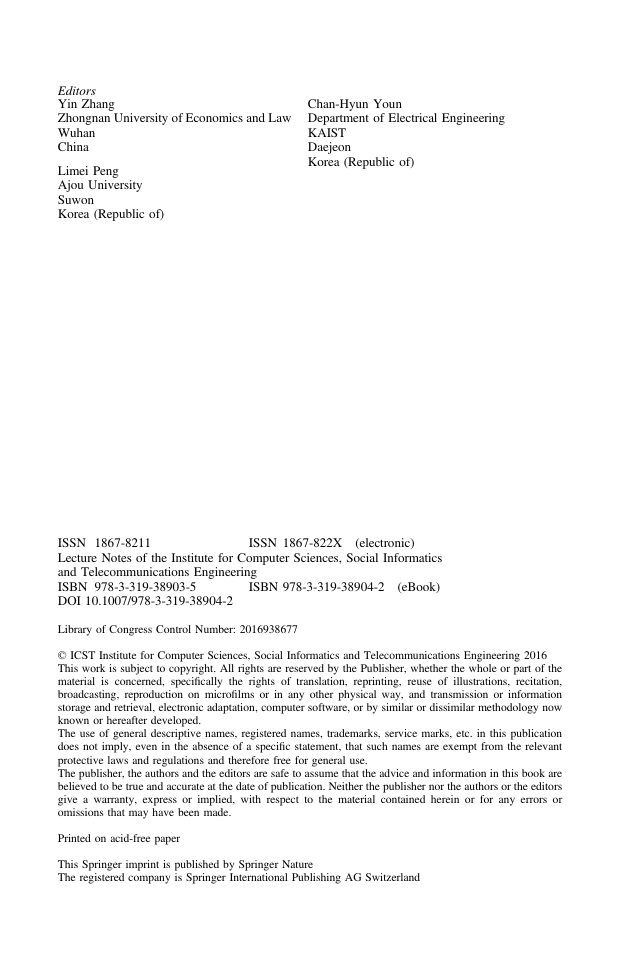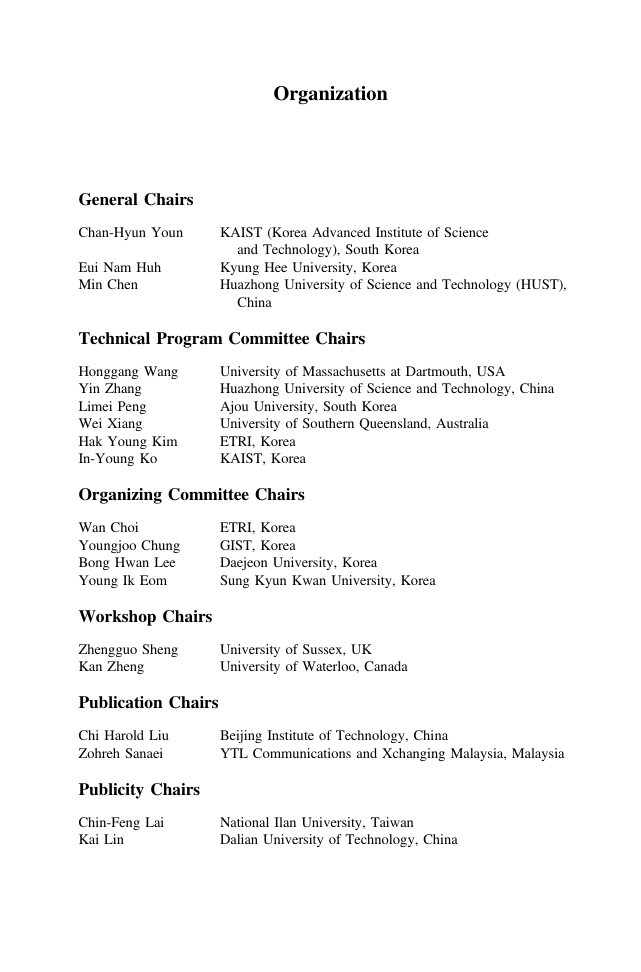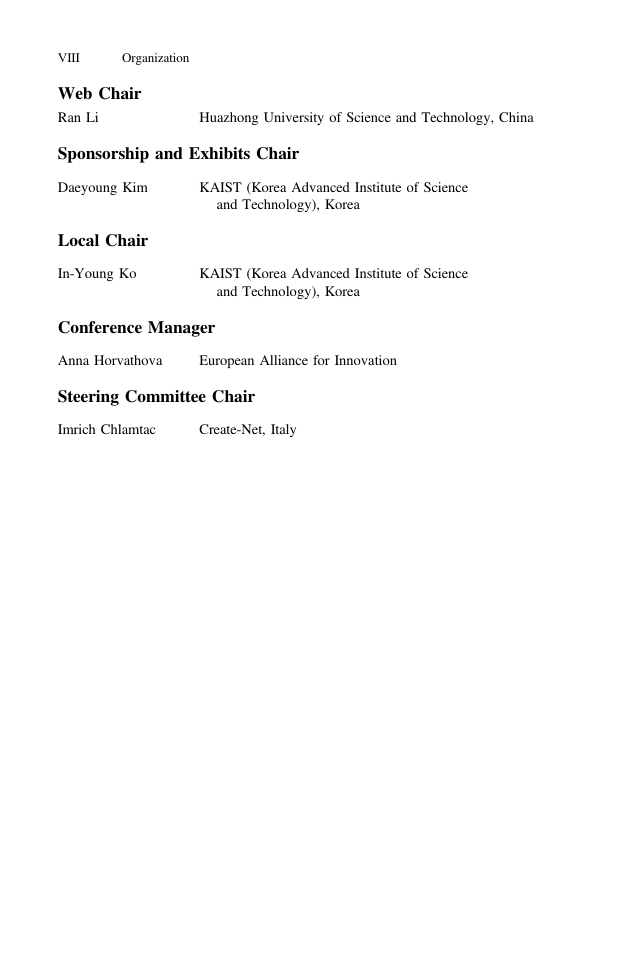Cover
Copyright
Preface
Contents
Virtualization and Management on Cloud
Automated Overlay Virtual Networking Manager for OpenFlow-Based International SDN-Cloud Testbed
Abstract
1 Introduction
2 OF@TEIN: International Distributed SDN-Cloud Testbed
2.1 SDN-Cloud Playground Interconnecting Multiple OpenFlow Islands
2.2 Automated Inter-Connection Provisioning Tools
3 Overlay VNetworking Manager
3.1 Design
3.2 Implementation and Working Procedure
3.3 Evaluation: Features and Limitations
3.4 OvN-Manager: Functionality Verification
4 Conclusion
Acknowledgments
References
An Educational Virtualization Infrastructure
Abstract
1 Introduction
2 Problem Statement
2.1 Research Questions
2.2 Significance of This Study
3 Related Work in Virtualization
4 Research Methodology and Analysis
4.1 Sample Size and Description
4.2 Proposed Survey Measures
4.3 Data Collection and Analysis
4.3.1 Statistics Relating to Students
4.3.2 Statistics Relating to Academic Staff
5 Conclusions
References
A Study of Resource Management for Fault-Tolerant and Energy Efficient Cloud Datacenter
Abstract
1 Introduction
2 System Structure
3 Portfolio Diversification Based Resource Management Scheme
4 Analytical Results
5 Conclusion
Acknowledgments
References
User Isolation in Multi-user Multi-touch Devices Using OS-Level Virtualization
Abstract
1 Introduction
2 Related Work
2.1 Window Manager
2.2 Virtualization Technologies
2.3 Case Study
3 Why OS-Level Virtualization is Necessary
4 Evaluation
4.1 Experimental Setup
4.2 Experimental Results
5 Conclusion
Acknowledgments
References
A VM Vector Management Scheme for QoS Constraint Task Scheduling in Cloud Environment
Abstract
1 Introduction
2 VM Vector Management Scheme in Task Scheduling
2.1 Modeling Task Consolidation in Cloud Computing Environment
2.2 Vector Models
2.3 Task Scheduling Algorithm with VM Vector Management Scheme
3 Experiments and Evaluation
3.1 Performance Metric
3.2 Application Service Scenario
4 Conclusion
Acknowledgement
References
An Adaptive VM Reservation Scheme with Prediction and Task Allocation in Cloud
Abstract
1 Introduction
2 VM Reservation with Prediction and Job Allocation
2.1 Problem Statement
2.2 A Proposed Model Description
3 Performance Evaluation
3.1 Prediction-Based VM Reservation with M-C-VMR
3.2 VM Utilization with M-C-VMA
4 Conclusion
Acknowledgement
References
A Cost-Effective VM Offloading Scheme in Hybrid Cloud Environment
Abstract
1 Introduction
2 Problem Description and Scenario
2.1 Video Streaming in Hybrid Cloud Environment
3 CHOV Model
4 Evaluation
4.1 Experiment Setting
4.2 Experiment Result
5 Conclusion
Acknowledgments
References
Dynamic Virtual Machine Consolidation for Energy Efficient Cloud Data Centers
Abstract
1 Introduction
2 System Model Formulation
3 Proposed System Structure
4 Experimental Results
5 Conclusion
Acknowledgments
References
Resource Management, Models and Performance
A New Framework for Cloud Business Process Management
Abstract
1 Introduction
2 Research Questions
2.1 Research Questions
3 Related Work in Cloud BPM
4 Research Methodology and Analysis
4.1 Data Collection and Sampling
4.2 Research Analysis and Results
5 Conclusions
References
On Increasing Resource Utilization of a High-Performance Computing System
Abstract
1 Introduction
2 Background
3 System Design
3.1 Architecture
3.2 Establishing Workers
3.3 Resource Fragment Monitoring
4 Fragment-Aware Scheduling Algorithm
5 Experiments
6 Conclusion
Acknowledgments
References
A Game Theory Based Automated SLA Negotiation Model for Confined Federated Clouds
Abstract
1 Introduction
2 Problem and Motivation
3 Related Work
4 Automated SLA Negotiation Model Based on Game Theory
4.1 Model Description
4.2 Illustrative Example of SLA Negotiation using Fair Division Game
5 SLA Negotiation Model Formulation
6 SLA Negotiation Model Evaluation
6.1 Test Scenarios
6.2 Results and Discussion
7 Conclusion
References
Experiences on Setting up On-Premise Enterprise Cloud Using OpenStack
Abstract
1 Introduction
2 Related Work
3 Requirements
4 Challenges
4.1 Selection of Hypervisor
4.2 Develop a Cloud Service Usage Model
4.3 Extension of External VLANs to GRE Based Tenant Network
4.4 Image Creation for OpenStack
4.5 Data Security
5 Solution
5.1 Selection of Hypervisor
5.2 Develop a Cloud Service Usage Model
5.3 Extension of External VLANs to the GRE Based Tenant Network
5.4 Image Creation
5.5 Data Security
6 Implementation
6.1 Service Request Portal
7 Result
8 Conclusion and Future Work
Acknowledgements
References
Performance Evaluation of Scientific Workflow on OpenStack and OpenVZ
Abstract
1 Introduction
2 Background
2.1 Virtualization
2.2 HTCondor
3 Related Work
4 Implementation
4.1 Setup
4.2 CPU Intensive Job
4.3 I/O Intensive Job
4.4 Memory Intensive Job
4.5 Network Intensive Job
5 Discussion
6 Conclusion
References
An Science Gateway with Cost Adaptive Resource Management Schemes
Abstract
1 Introduction
2 A Model Description of the Science Gateway
3 Cost Adaptive Cloud Resource Management Schemes
4 Test Environments and Performance Evaluation
5 Conclusion
Acknowledgments
References
Hybrid Workflow Management in Cloud Broker System
Abstract
1 Introduction
2 A Hybrid Model of the Parallel Task Merging and Auto-Scaling Algorithms in Cloud Broker System
2.1 Problem Description
2.2 The Parallel Task Merging and Auto-Scaling Scheme
3 Experimental Environment and Performance Evaluation
4 Conclusion
Acknowledgments
References
Mobile Cloud and Media Services
Mobile Cloud Computing System Components Composition Formal Verification Method Based on Space-Time Pi-Calculus
Abstract
1 Introduction
2 Basic Conceptions
2.1 MCS Service View
2.2 S-T Pi-Calculus
3 A Formal Verification for MCS Components Composition
4 Experiments and Results
5 Conclusion
References
Monitoring Prayer Using Mobile Phone Accelerometer
Abstract
1 Introduction
2 Related Work
3 Prayer Activities Detection System
4 Evaluation and Results
5 Conclusion
References
A Prospective Cloud-Connected Vehicle Information System for C-ITS Application Services in Connected Vehicle Environment
Abstract
1 Introduction
2 Proposed Architecture of Prospective Cloud-Connected Vehicle Information System for C-ITS Application Services in Connected Vehicle Environment
3 Scenario Case: Procedure of Local and Global Vehicle Information System
4 Conclusion
Acknowledgments
References
Video and USB Transmission Devices for Cloud Desktop Service
Abstract
1 Introduction
2 Video and USB Transmission Devices
3 Simplified Switch Structure
4 Implemented Results
5 Conclusion
Acknowledgement
References
A Feature-Oriented Mobile Software Development Framework to Resolve the Device Fragmentation Phenomenon for Application Developers in the Mobile Software Ecosystem
Abstract
1 Introduction
2 Background
2.1 The Device Fragmentation Phenomenon
2.2 Feature Model
2.3 Classification of Mobile Device Features
3 A Feature-Oriented Mobile Software (FOMS) Development Framework
3.1 Methodology
3.2 A Conceptual Example for the FOMS Development Framework
4 The Automation of Compatibility Calculation
5 A Case Study
6 Related Works
7 Conclusion
Acknowledgments
References
Improving Data Access for Smart World
Abstract
1 Introduction
2 Related Work
3 System Architecture
4 Simulation
5 Conclusion
References
Pervasive Cloud Applications, Services and Testbeds
Implications of Integration and Interoperability for Enterprise Cloud-Based Applications
Abstract
1 Introduction
2 Cloud Integration
2.1 Survey Findings and Analysis
2.2 Cloud Integration Imperative
2.3 Approaches for Cloud Integration
3 Interoperability Considerations
4 Conclusion
References
Building and Operating Distributed SDN-Cloud Testbed with Hyper-Convergent SmartX Boxes
Abstract
1 Introduction
2 Design of Distributed SDN-Cloud Testbed
2.1 Computing/Networking-Balanced Testbeds
2.2 Hyper-Convergent SmartX Box: Design
2.3 Virtualized SDN-Enabled Switches and Cloud-Leveraged VMs
2.4 Automated Provisioning
2.5 SDN-Cloud Centralized Management
3 Verification and Evaluation
3.1 Multi-Site Deployment for Distributed SDN-Cloud Testbed
3.2 Semi-Automated Provision: Verifications and Evaluations
3.3 Example Experiments with SDN-Cloud Playground
Acknowledgements
References
On Providing Response Time Guarantees to a Cloud-Hosted Telemedicine Web Service
Abstract
1 Introduction
2 Design of Telemedicine Service
3 Experimental Setup
3.1 Cloud Testbed
3.2 Experimental Design
3.3 Synthetic Workload Generation
4 Experimental Results
4.1 Experiment 1: Static Allocation Using EC2 Medium Instance
4.2 Experiment 2: Static Allocation Using EC2 Large Instance
4.3 Experiment 3: Static Allocation Using EC2 Xlarge Instance
4.4 Experiment 4: Static Allocation with Distributed Workload Generation
4.5 Experiment 5: Dynamic Allocation Using EC2 Medium Instances
5 Conclusion and Future Work
References
Modeling Parallel Execution Policies of Web Services
Abstract
1 Introduction
2 Motivating Example
3 Parallel Invocation of a Web Service
3.1 Performance Speed-Up
3.2 Parallel Execution Policy Model
4 Testing Methodology
5 Experiments
5.1 Combination of Slow-Down Policy and Restriction Policy
5.2 Combination of Slow-Down Policy and Penalty Policy
5.3 Evaluation
6 Related Work
7 Conclusion
References
A Hybrid Cloud Computing Model for Higher Education Institutions in Saudi Arabia
Abstract
1 Introduction
2 Cloud Computing Model for Institutions
3 Efficacy of Model
4 Conclusion and Future Work
References
A Methodology to Select the Best Public Cloud Service for Media Focussed Enterprises
Abstract
1 Introduction
2 The Selection and Buying Processes in Vogue
3 A Paradigm Shift in the Buying Process
3.1 The Shortcomings of a Filter Based System
3.2 The Shortcomings of Research Reports
3.3 The Dynamic Component in Ranking
4 A Path Breaking Evaluation Methodology
4.1 Defining the Meaning of a Priority Value
4.2 Identifying Key Technology and Business Requirements ("Must Have") of Media Companies
4.3 Identifying Additional Technology and Business Requirements of Media Companies
4.4 Identifying Parameters Which Define Requirements
4.5 Setting Priorities for Each Requirement
4.6 What to Look at to Zero in on a Cloud Service Provider
5 Vendor Scores and Sample Charts
5.1 Top Vendors for User Assigned Priorities for Requirements
5.2 Top Vendors for All Requirements with Equal Priorities
6 Conclusion
A Cloud Computing System Using Virtual Hyperbolic Coordinates for Services Distribution
Abstract
1 Introduction
2 Related Work
3 Poincaré Disk Models Properties
4 Hyperbolic Greedy Routing
5 Strategy of Naming and Binding on Our Cloud System
6 Experimental Results
6.1 Load Balancing in Our System
6.2 Performances Analysis
7 Conclusion
References
Enabling SDN Experimentation with Wired and Wireless Resources: The SmartFIRE Facility
Abstract
1 Introduction
2 Testbeds and Interconnections
2.1 South Korean Testbeds
2.2 European Testbeds
2.3 GEANT and KREONET/KOREN Interconnecting Networks
3 Experimentation Framework and Federation Architecture
3.1 Users Management and Resources Reservation
3.2 SFA Aggregate Manager (AM) for SmartFIRE Federation
3.3 Experiment Control: OMF
4 Experimentation Capabilities Provided by SmartFIRE
4.1 ICN Experimentation
4.2 MOFI Experimentation
5 Conclusion
References
Cloud-Enabling Techniques and Devices
A Buffer Cache Algorithm for Hybrid Memory Architecture in Mobile Devices
Abstract
1 Introduction
2 Background
3 Proposed Algorithm
4 Evaluation Results
5 Conclusion
Acknowledgement
References
Protocol for a Simplified Processor-Memory Interface Using High-Speed Serial Link
Abstract
1 Introduction
2 Memory Systems and Protocol Engines
2.1 Proposed Memory Structure
2.2 Proposed Protocol Engines
3 Operation of Protocol Engine
3.1 Write Operation
3.2 Read Operation
4 Test for Read and Write Access
4.1 Test Setup
4.2 Experimental Results
5 Conclusion
Acknowledgement
References
The Trapping Device Implementation of Wireless Sensor Network
Abstract
1 Introduction
2 System Block Diagram and Flowchart
3 System Configuration
3.1 Solar Panel
3.2 Wireless Communications
3.3 PIR Motion Sensor
3.4 Soil Moisture Sensor
4 Conclusions
References
A Formal Approach for Modeling and Verification of Distributed Systems
Abstract
1 Introduction
2 Modelling a Scenario Using Sequence Diagram
3 From Sequence Diagram to Π-calculus
4 FromΠ-Calculus into NuSMV
5 Model Checking for Temporal Property
6 Conclusion
References
Design of a Security Gateway for iKaaS Platform
Abstract
1 Introduction
2 iKaaS Platform
3 Functions of Security Gateway
3.1 Privacy Certificate
3.2 Security Policy
3.3 Privacy Policy
3.4 Access and Privacy Control
3.5 Cache Management
4 Protocol
4.1 Query Formats
4.2 Step Sequence
5 Conclusion
References
KVM-QEMU Virtualization with ARM64bit Server System
Abstract
1 Introduction
2 APM X-Gene Server Reference Platform
2.1 Software Development Environment
3 KVM-QEMU Virtualization on ARM64
3.1 KVM Kernel Configuration and Host OS
3.2 ARM64-QEMU Setup
3.3 Making a qcow2 Image for Guest OS
3.4 Getting Netboot Image
3.5 Guest OS Setup Using Netboot Image
3.6 Starting Guest OS
4 Experimental Result
5 Conclusions
Acknowledgments
References
A System Interconnection Device for Small-Scale Clusters
Abstract
1 Introduction
2 Related Work
3 Using PCI Express for System Interconnects
3.1 Advantages and Disadvantages of PCI Express for System Interconnects
3.2 Data Transmission Mechanism Through Non-transparent Bridges
4 Design and Implementation of PCIeLINK
4.1 Hardware Design and Implementation
4.2 Software Design and Implementation
5 Evaluation and Discussion
5.1 Description of Test Environment
5.2 Experiment Results and Performance Evaluation
6 Conclusions
Acknowledgments
References
Author Index
















 2023年江西萍乡中考道德与法治真题及答案.doc
2023年江西萍乡中考道德与法治真题及答案.doc 2012年重庆南川中考生物真题及答案.doc
2012年重庆南川中考生物真题及答案.doc 2013年江西师范大学地理学综合及文艺理论基础考研真题.doc
2013年江西师范大学地理学综合及文艺理论基础考研真题.doc 2020年四川甘孜小升初语文真题及答案I卷.doc
2020年四川甘孜小升初语文真题及答案I卷.doc 2020年注册岩土工程师专业基础考试真题及答案.doc
2020年注册岩土工程师专业基础考试真题及答案.doc 2023-2024学年福建省厦门市九年级上学期数学月考试题及答案.doc
2023-2024学年福建省厦门市九年级上学期数学月考试题及答案.doc 2021-2022学年辽宁省沈阳市大东区九年级上学期语文期末试题及答案.doc
2021-2022学年辽宁省沈阳市大东区九年级上学期语文期末试题及答案.doc 2022-2023学年北京东城区初三第一学期物理期末试卷及答案.doc
2022-2023学年北京东城区初三第一学期物理期末试卷及答案.doc 2018上半年江西教师资格初中地理学科知识与教学能力真题及答案.doc
2018上半年江西教师资格初中地理学科知识与教学能力真题及答案.doc 2012年河北国家公务员申论考试真题及答案-省级.doc
2012年河北国家公务员申论考试真题及答案-省级.doc 2020-2021学年江苏省扬州市江都区邵樊片九年级上学期数学第一次质量检测试题及答案.doc
2020-2021学年江苏省扬州市江都区邵樊片九年级上学期数学第一次质量检测试题及答案.doc 2022下半年黑龙江教师资格证中学综合素质真题及答案.doc
2022下半年黑龙江教师资格证中学综合素质真题及答案.doc